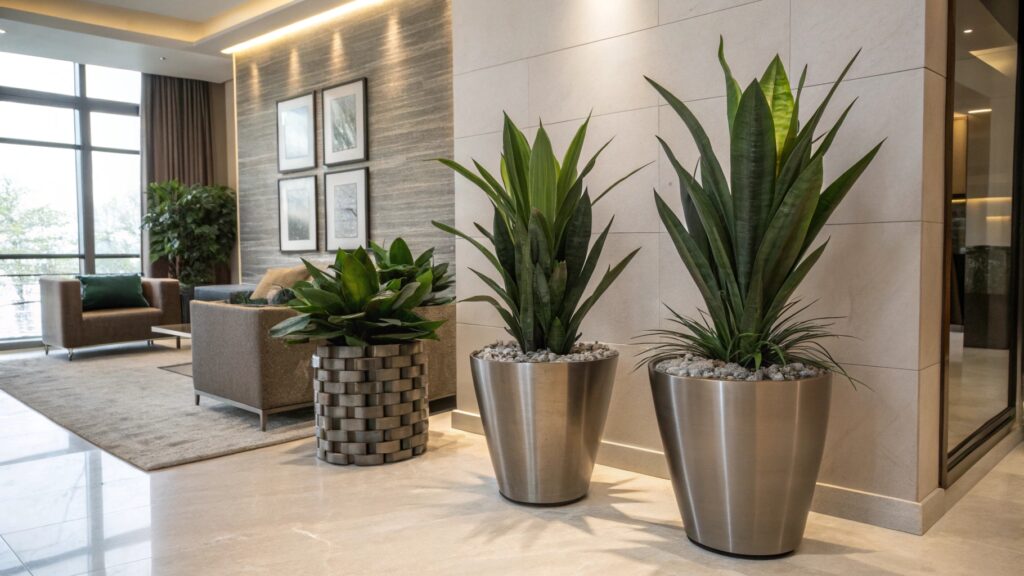Fake plants are a simple solution to decorating your living room and making it look new and welcoming to guests without the need to water, prune, or clean up dead leaves. You do not have to have a green thumb to feel the relaxing effect of greenery in your house. Regardless of whether you are living in a small apartment or a large house, artificial plants allow you the liberty of decorating your living space with the color and texture that can remain beautiful throughout the year.
Our experience in the production of realistic artificial plants at FeelReal dates back more than 20 years. This guide will provide you with information on the best kind of artificial plants to use in your living room, the best location to site them and how to ensure that the fake plant is as realistic as it can be.
What Types of Fake Plants Work Best for Living Rooms?
The proper selection of the fake plants will make your area look more calm, individual and trendy. Whether you like cuddly farmhouse aesthetics or sleek and minimalistic ones, there is a fake plant out there to fit every choice.

In order to appear as natural as possible, it is worthwhile to intermix big plants, medium ones, and small ones. This adds variety to it and your room will look like you have everything in balance. It also assists in taking up the space and provides the illusion of growth, as it happens in reality in nature.
Fiddle Leaf Fig, Olive Tree, and Ficus are some of the most common residential favorites, and they are a good choice, especially since they are a classic with delicate foliage that fits both minimalist and luxury interiors. Seek quality materials and not cheap-looking plastics and think about purchasing them from a reliable artificial plant seller who focuses on realistic details.
Grand Statement Plants
Large fake plants are your best bet in striking a big change. They do not only have to fill up the space; these oversized plants serve as decorative accents, introducing liveliness and character to the room. They work great in a high-ceiling or empty corner, or as the division of a space on an open plan. Taller plants (with greater movement) will also captivate your attention towards the higher direction and will make your living area appear larger and friendlier.
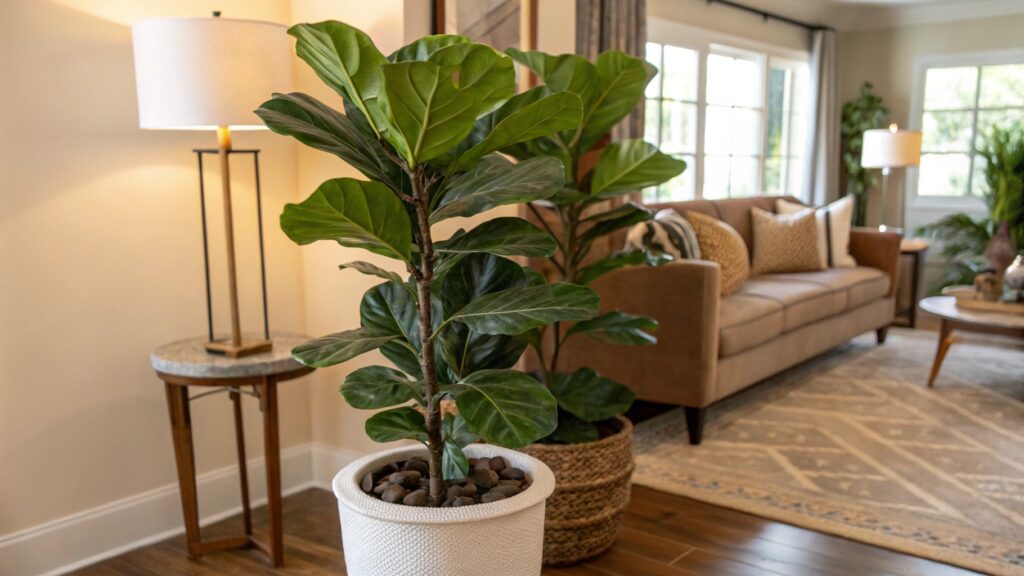
Fiddle leaf trees: With a lot of shiny foliage and a sculptural appearance, fiddle leaf figs add a clean and modern touch to the room or the entrance. Interior designers prefer them owing to their unique shape of leaves.
Artificial olive tree: Synthetic-olive trees are lacy in their branches and modest in their gray-green leaves. They appear in a way that casts more of an airy and fine visuality without bits of overstatement in the volume of visuality.
Palm trees: Faux palms create an immediate feeling of the tropical atmosphere, and so they are a great choice to use in light, airy interiors. They suit best in homes based on coastal, eclectic, or resort styles. The broad sweeping fronds of these plants create a strong style statement as well as rounding out the edges.
Bird of paradise: This theatrical plant has long stalks and banana-shaped foliage, ideal for people who would like to bring something artistic to the wall. It is particularly handy in making the rooms that are monochrome, or even modern-themed, visually interesting.
Such plants help turn the eye upwards and divide bare walls and provide the living room with structure and movement. They also introduce a more sized-up and advanced look when utilized with smaller types of plants.
Medium-Sized Options
Medium fake plants are light in terms of flexibility and balance. They can be used to fill those weird areas between furniture, around the windows, or can be used to make room corners look softer without overwhelming them. The reason is that they are of a middle size between the large focal points and small accessories and serve as connectors in your general room design.
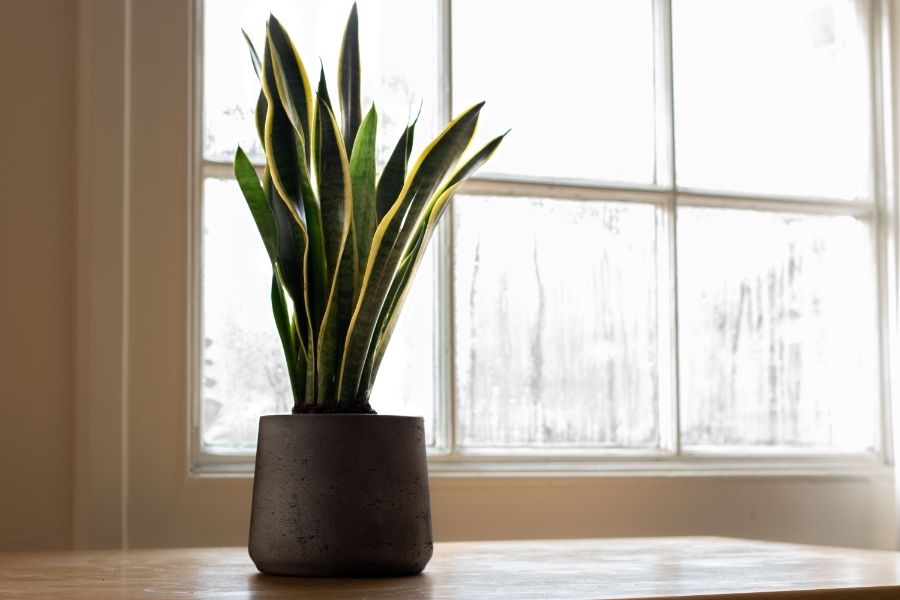
Snake plants: They are long and pointy with leaves which rise up tall and make your design a shape. Their sharp silhouette can fit into minimalist, clean or Scandinavian style houses. They are ideal for those people who desire a sleek, architectural kind of thing.
Rubber plants: Rubber plants are a rich plant with dark green leaves with a shiny effect, making them appear deep-rooted. They are used effectively along with bookcases or as filler in the bigger pieces.
Maidenhair ferns: These faux ferns are available in cream limestone or other darker colour schemes to act as a contrast to hard material feathers or coffee tables. They can particularly be used in softening the edges of something sharp or making the dark sides lighter.
Medium sized artificial plants are more suitable when they are potted in decorative planters that add beauty to the imitated foliage. Plastic should be avoided because it is shiny; seek textured material or hand-painted to provide an air of reality.
Small Accent Plants
Never underestimate the importance of the small artificial plants. They are the key to depth and a well-decorated interior. These accents will allow smoothing sharp corners, creating your own style and uniting all your decorations. With the small plants, there is a chance to experiment with various textures, colors, and container shapes and not invest a lot of money.
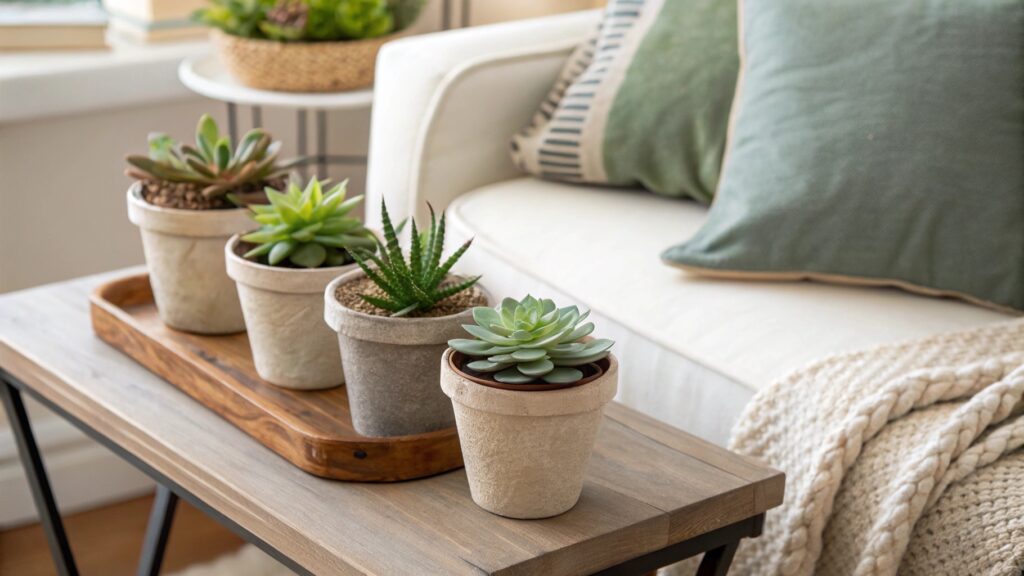
Succulents: Fake succulents provide small bolts of green and appear amazing in a variety of ornamental trays, on windowsills, or with candles and books. They are easy to fit anywhere in virtually every decoration due to their low profile and modern shapes.
Orchids: Artificial orchids are classy and will also make your decor appear expensive. They can be used as an entry table, a mantel, or a nightstand because of their soft compounds and dainty flowers. They particularly perform in official or posh areas.
Eucalyptus: Put forged eucalyptus stems in vases and combine them with seasonal decorations. They are subdued in green colour, which and their basic silhouette are compatible with nearly every interior design.
To make it even more elegant, you can use a Bonsai tree as table center-pieces since its small size will provide serenity and sculptural beauty. These little yet elegant accents may add some luxury to your decor, particularly when they are put in the quality pots or on decorative trays.
Where to Place Fake Plants for Best Effect?
Once you have made your selection of the plants, it is time to use them. The arrangement may totally change the perception of your greenery, may give artificial plants a natural look, may enhance the arrangement in your room, and may create points of interest. Placement of elements is essential as well to control the flow of traffic and to maintain a sense of order and unity within the area.
- In corners: Filling them up with tall plants is a wonder-worker. A big tree attracts attention to the top area and plugs the embarrassing holes, and also gives the room a complete, clutter-free feeling.
- Near natural light: The UV-protected artificial plants can be placed close to windows, since it would be similar to the real plantations, resulting in a realistic scenario that emulates real life more closely. This installation plays with the eye and gives your decor one more dose of authenticity.
- Shelves and mantels: Place smaller plants to interrupt books and decoration on the shelves. They put in textures, smoothen sharp edges and provide natural flow to strict designs.
- Near the furniture: Put a medium-sized plant next to a sofa, armchair or a TV console. It brings color; it gives balance in the design and it also offers a slight delineation to each aspect of the room. Such placements make the greenery more interactive even relating it to the daily lives.
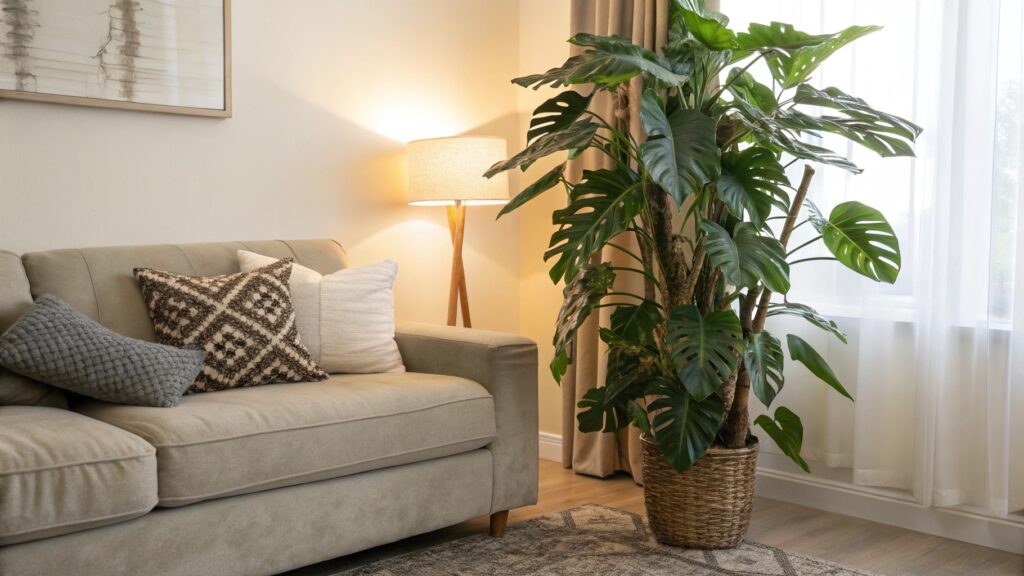
Putting your fake plants in strategic places contributes towards making them match perfectly with the rest of your surroundings. Soften walls or ceilings with hanging planters that have trailing vines. These potted accents are fantastic in a Boho or contemporary home interior and introduce movement to your room in a vertical direction. The idea here is to create an impression of making the plant fit in the area, just as the lifelike foliage would.
Styling Tips – How to Make Fake Plants Look Natural Indoors
In order to create your fake foliage realistically, please pay attention to the way you are showing and taking care of it. Even the most realistic artificial plant may lose its magic, being put in plastic pots or being dusted. Here is how to make them attractive and presentable enough not to look stale.
- Variation in mixtures and shapes: Nature is diverse, hence do not confine yourself to one kind of plant. Large-sized team floor trees, medium-sized plants with leaves, and small indoor plantation. This will enhance a more realistic and vibrant outlook. It also fits well in the restoration of the textural stratified beauty of actual gardens.
- Make attractive pots: Get rid of the unsightly nursery pots and use pretty pots such as woven baskets, a ceramic planter, terracotta, or concrete. These are supportive materials that bring in weight, cosmetic appeal, and hand-crafted textiles to your decor work.
- Clean them: You may also keep refreshing your artificial plants by cleaning them with a microfiber cloth or blowing off dust from their leaves using a hair dryer, which is turned cool.
- Buy a natural partner: Keep your plants in a wood, stone, rattan, or linen decor so that they can blend in with real-life items in your house. This makes it richer and assists in incorporating the fake trees and plants into the theme you already have.
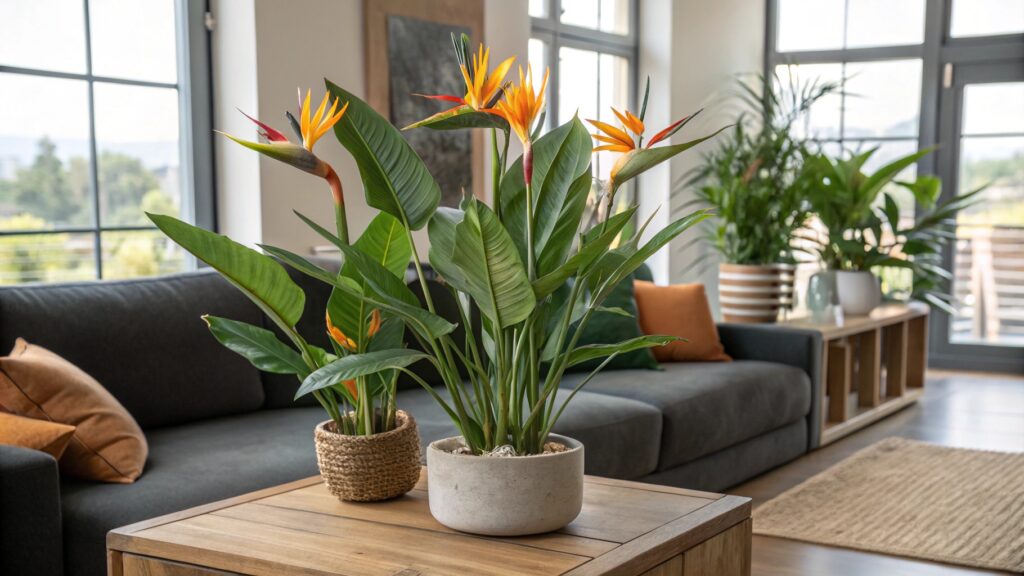
By selecting imitation plants of good quality provided by a reliable supplier, you will make your decoration look sophisticated and professional. The aim is to determine the aesthetic environment of a natural effect, without maintenance.
Season Decorations with Realistic Artificial Plants
Combine the past and present by being able to switch your plant ambience with the seasons, and have a constantly new decor of plants. When in spring, make some moss or place your greens in pots which are in soft pastel color. In fall, it is possible to cover planters with warm color fabrics, or even to cover with pumpkins and branches.
When considering winter holidays, you may also decide on fairy lights or some lightweight metal decorations. One can even change the planter bases or accent objects, like plant stands and trays. Making such easy adjustments will assist you in making sure you can enjoy your artificial plants regularly, all year round, in the house without them appearing to be stagnant or tired.
Conclusion
Decorating your living room with artificial plants is cheap and saves you the hassles of homage to nature. They pass to your serenity, color and vigor to your home and you do not even need a watering can or a plant care manual. Fake plants are insanely versatile and have a timeless good-look, so whether you want tropical floor palms, fashionable succulents, or a handful of little tabletop florals, you can get it all with fake plants (and all it takes is a quick Google).
With FeelReal, we make every artificial plant to be realistic and precise. Our products are durable and impressive, with the likes of silk leaves to UV-enduring finishing. Are you prepared to transform your living room area into the green, peaceful paradise that looks perfect at all times? Shop and take home the just right combination of class and comfort. And not to forget: your living room also needs to live and be loved, even when all foliage is artificial.
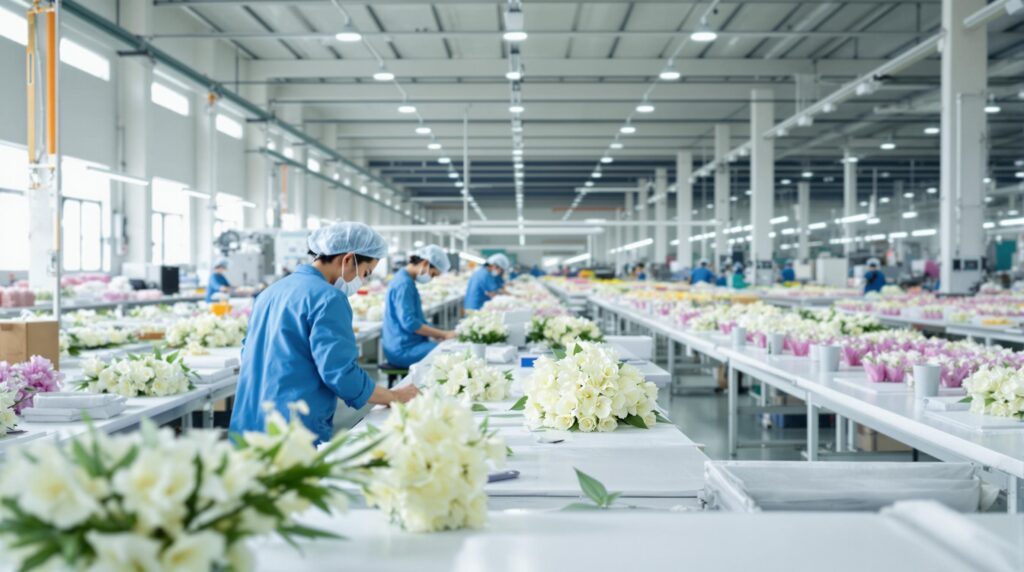
FAQs about Indoor Artificial Plants Decoration:
Q1: How do I keep fake plants from getting dusty?
Wipe the fake plants using a soft cloth once in a week to keep making them look new. In sticky areas, cool-blow drying helps brilliantly. To get rid of grime apply a slightly damp cloth and a mild soap. It can be withstood by our plants and it does not fade due to UV protection in our plants.
Q2: Which fake plants are the best to be used in living rooms?
Some of the fake plants look more real than others. The finest of them are:
- Fiddle Leaf Figs because they have large and coarse leaves and thick stems.
- Olive Trees (naturally lanky-branched, and of a lightish colour-tint).
- Rubber Plants which provide a deep rich green appearance.
To obtain the most realistic effect, look for the details such as veins of leaves, colour gradation, and bends which could have a natural look as to the stems, not to mention the fact that it is a good idea to alternate their placement sometimes to create an illusion of improvement and refresh the appearance of your decor.

